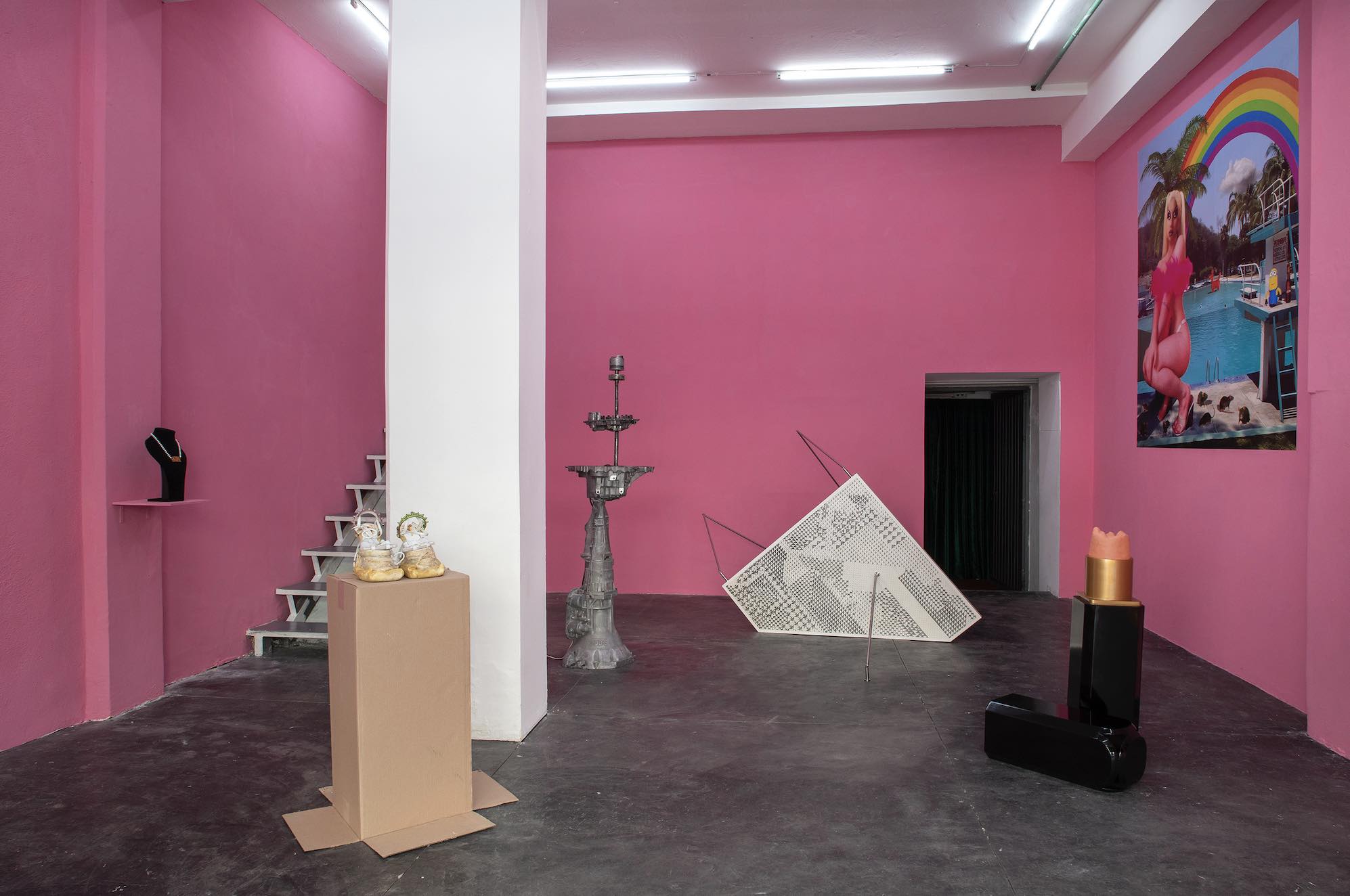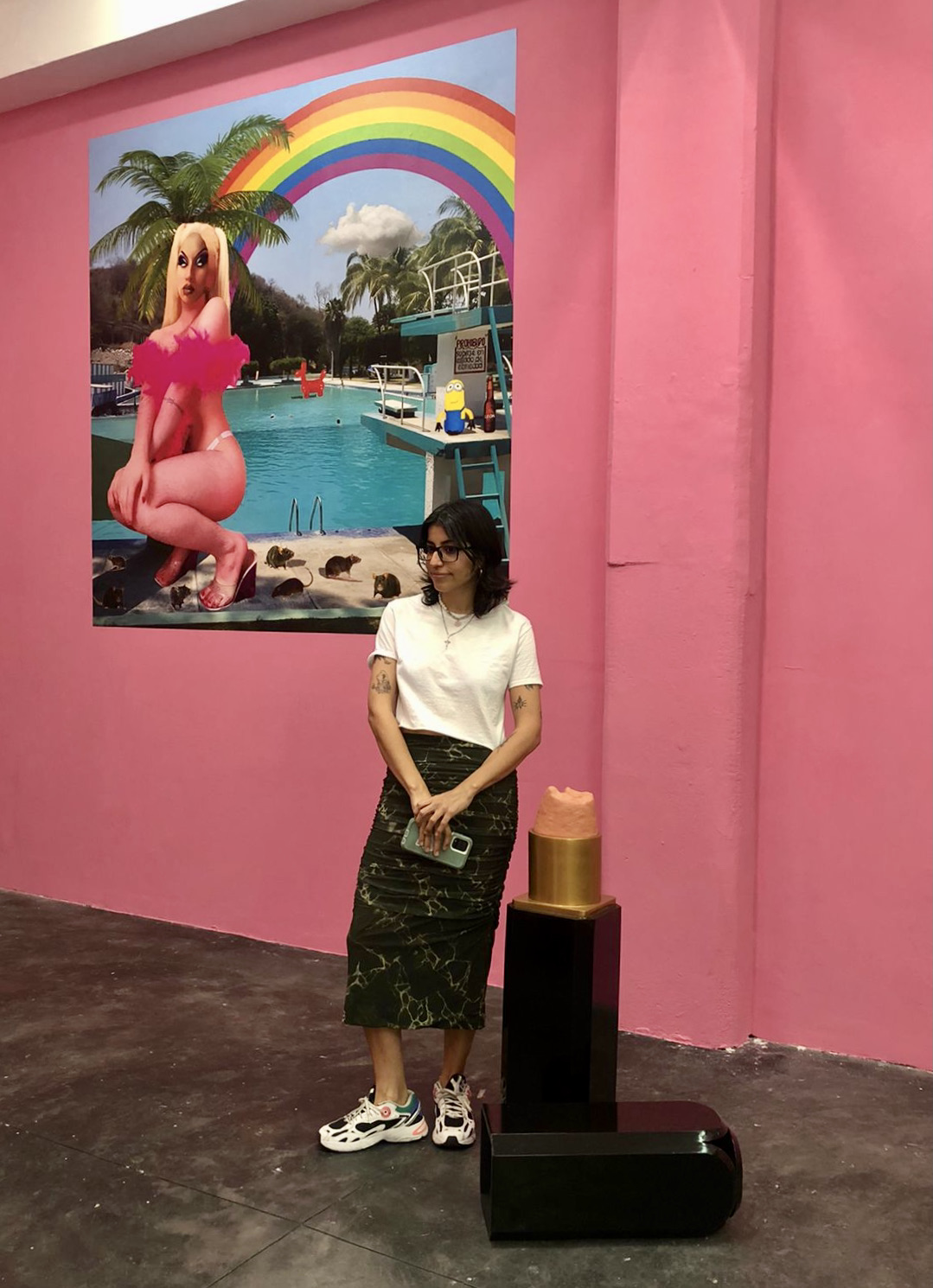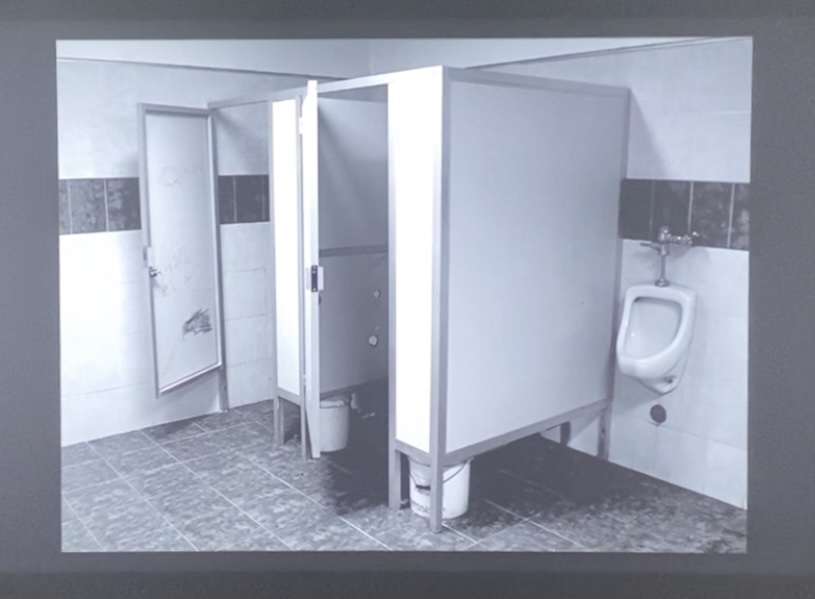
Review
Arte de zorras at General Expenses
by Sandra Sánchez
Perhaps every object is a transitional object
Reading time
6 min
⠀⠀⠀⠀⠀⠀⠀⠀⠀⠀Placer. Placer.⠀⠀⠀⠀⠀⠀⠀⠀⠀⠀
⠀⠀⠀⠀⠀⠀⠀⠀⠀⠀Placer. Place.⠀⠀⠀⠀⠀⠀⠀⠀⠀⠀
⠀⠀⠀⠀⠀⠀⠀⠀⠀⠀⠀Lace. Ace. ⠀⠀⠀⠀⠀⠀⠀⠀⠀⠀⠀
⠀⠀⠀⠀⠀⠀⠀⠀⠀⠀⠀⠀Pace.⠀⠀⠀⠀⠀⠀⠀⠀⠀⠀⠀⠀⠀
A Bilezote (Samuel Nicolle, 2021-2022), or big lipstick, about to give out, as though bitten. Melon color. It’s big, and comes up to my waist. What part of the body will it paint? Will I be able to sit on it? To cover myself with it? MDF with automotive lacquer for the black packaging, cold ceramic for the material. It recalls the lipsticks that our moms never threw away, that smelled bad when you put them on, that were left waiting for the next happening. Gaby Cepeda, who curated Arte de zorras (roughly, “Slut Art”), together with Natalia de la Rosa and Lic. Sniffany Garnier Odio, says to me: “pleasure” (placer). “The slut of this exhibition claims her own agency, her power to decide the how and the when of her pleasure and the sovereignty of her desire. This slut is closer to leisure and delight; she disdains work and doesn’t seek remuneration. Everything she does, she does for pleasure,” as the gallery text puts it. I think that the slut is a symptom (the repetition in the body of work of various artists marked by that sensation), with a reading as a figure of thought that assembles mutuality. I celebrate the curating as long as it shapes a gaze, (((an epistemic and corporal one. Place))) and lets us see something that was there, but had no name; now it’s called slut art. Gaby tells me that they wanted to distinguish the slut from the sexualized anthropomorphic body (((there’s a body on the wall, occupying a large space, Palo bolero (Triste Trópicos, 2022), but without reproducing stereotypes, and instead spoiling several. We see a digitally dragged-out body crouching down, accompanied by rats at a Mexican resort, while a Koons puppy floats on the water))). On the way to eat, Gaby tells me about the faith she has in objects and what they can activate. I return to Trans Misión Automática (Katia Tirado, 2017), a fountain made with a trailer transmission that drips and splashes onto the floor, and in my notes I read: “Not every oozing body is a naked body.” It’s not ejaculation as an event, but the continuous repetition of a throbbing sensation. I think it’s my favorite piece in the exhibition, not only because it breaks the subject/active-object/passive relation, but also because it sustains a pleasure that does not amount to maximum ecstasy, owing to the heroic glory of a sublime achievement.


Arte de zorras makes me think of Chris Kraus’s I love Dick, especially when it comes to breaking with biography as linearity, as identity, in order to present it in different assemblages—her relation with her husband, the fantasy they hold about a third party: what they write to this person, the way they invent it, the vulnerability of not enunciating herself from her identity and her properties, but rather from the alliances and cuts that are shaping what she is becoming, without ever reaching the completeness of her own person-character. I think there’s a similar operation here; it’s not a matter of defining pleasure, much less the slut and her art, but of enunciating a different becoming (((Lace. Always unfinished, always in progress, and that overflows any livable or lived matter. It’s a process, that’s to say, a passage that goes through the livable and the lived… To become is not to reach a form (identification, imitation, mimesis), but rather to find the zone of vicinity, of indiscernibility, or of indifferentiation. Deleuze in Essays Critical and Clinical))). That’s to say, to dislocate the pleasure of the sado-maso, active-passive binary, to place it in a rhythmic gerund, always in tension with the transparencies and opacities. I think of the panels of Aby Warburg, of the necessary condition of the whole in forming a body, and then a symptom, and then writing on the panel itself, which is the surface of registration. From this point there is no possibility of isolating the meaning of a work as unique and unrepeatable: if a work exists and has something legible it’s because of the choreographies that accompany it and leave it between collapsed times and diverse spaces. “Glory Hole”: a forced laugh—a laugh that emulates the television perverse—interrupts and accompanies the narration of different spaces where the meeting can take place in the city of Puebla. We see images of those places: neglected, filthy, alone without bodies, the well-kept gray scale, almost documentary images. Could this work–TxstdTmpc (Isaac Olvera, 2019)–be read as documentary? The information is gathered from the internet, the gaps in the images feel like when you pass in front of a cantina very early and the white lights show its imperfections—all of them! And the smell wants you to throw up. But at night, at night that scenario was something else, the surface of pleasure/placer-Pace and shared hallucination. I return to the Bilezote (the big lipstick), to the worn-out platforms: Chancla (La Cholla Jackson, 2022), or “Slipper,” on top of a pedestal-cardboard box, the nickel-free gold-plated pendant and diamond sparkles supported by a pearl chain and gold golfi clasp—Zorra comunista (Tatyana Zambrano, 2021), “communist slut”—and I think of how all these objects are used. Using, operating, circulating. They aren’t works that invite you to think about a series of ideas (critical or not), but rather to trace objects that carry with them the imprint (real or phantasmal) of the places where their action took place in the present continuum. I dare to point out that now, here, they’re taking a rest. The rhythm of pleasure and its need for space, for momentary emptiness (even if infinity fits in an instant), for inertia. The pleasures that are imperceptible to the eye-ace. The vibration that charges an object. The asemic or symptomatic writing that takes place there. Avoiding thinking about the archive, instead looking at a palimpsest. Perhaps every object is a transitional object.

.jpeg?alt=media&token=2aeb1bb9-68c7-44ff-969d-cdea6a1f7e7e)
Arte de zorras also presents pieces by Betty Árbol, Madeline Jiménez Santil, Claudia Maté, Murakiit, and Daniela Rossell, as well as the neon street sign Juicy (2022) by Arte de Zorras. The exhibition can be visited at General Expenses until January 17.
Translated to English by Byron Davies
Cover picture by Bruno Dario
Published on December 10 2022